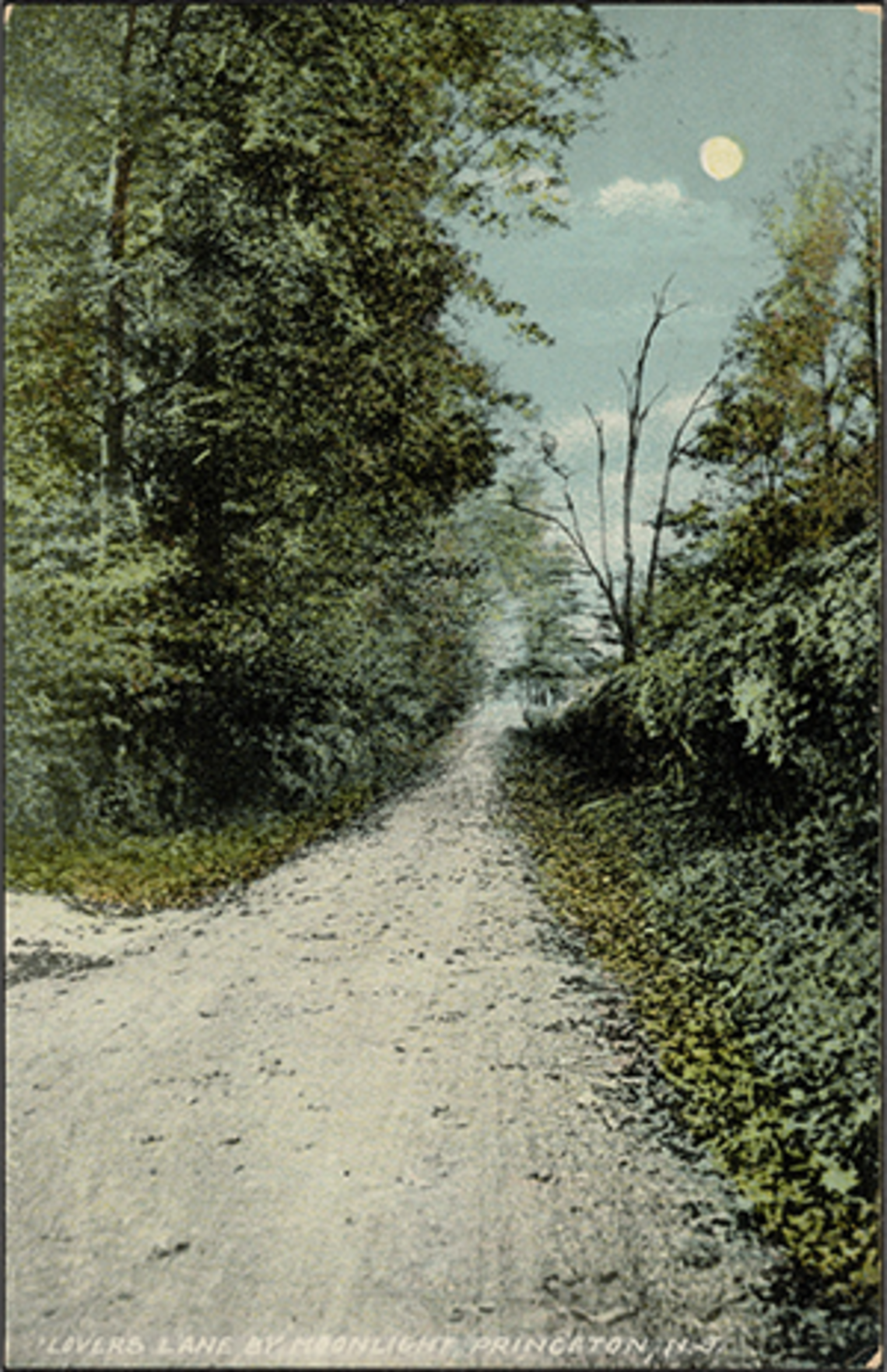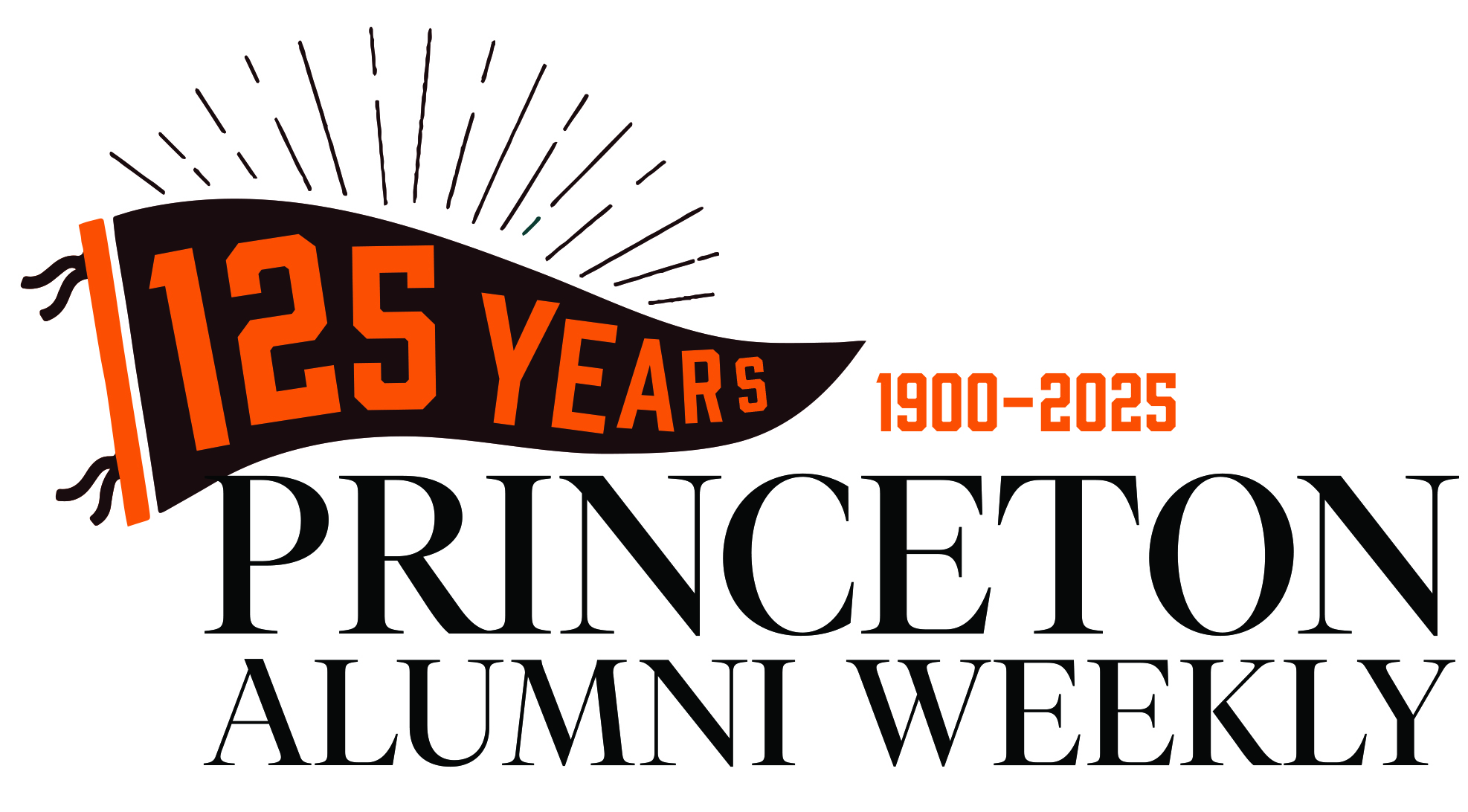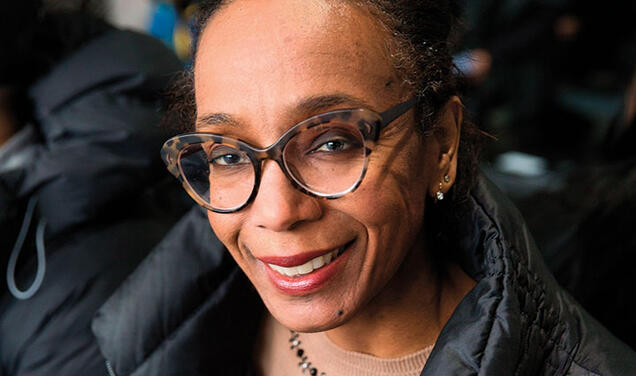
I love you and you’re not fickle,
You’ve got five cents and I’ve got a nickel,
We’ve got love and a dime.
— Brooks Bowman ’36, from the Triangle Show Stags at Bay
Being fashion-forward brings with it a set of subtle pressures. There’s the ceaseless competition with younger fashionistas trying to outdo you, and there’s the concern for the inevitable outcome, as Bob Dylan noted in “Foot of Pride”: “You know what they say about bein’ nice to the right people on the way up, sooner or later you gonna meet them comin’ down.”
At least that’s my experience. Not so much in the realm of haute couture (see example, right), but certainly in keeping my paw on the pulse of alumni concerns and fixations over the years, from the Nude Olympics to the Riot of 1807 to tea at Fine Hall. The latest example of this cutting-edge timeliness is the current lavish theme issue of Your Favorite Periodical, dedicated to love in all its wondrous aspects. I always try to sync up with the January theme, mainly because it’s generally fun and/or thought-provoking, but in this case my own conceptual leadership has played me false: Rally ’Round the Cannon has been there, done that. In fact, I’d accuse the editorial power structure of stealing my intellectual property, except 1) it’s not very intellectual, 2) they’d hurt me, and 3) the choice probably has more to do with somebody on the staff needing a date.
Anyhow, we have here previously taken a rich, varied look at love on campus, whose history is rather muted by the significant impediment of 223 years of unisex Presbyterian orthodoxy — a phrase that in itself has more structural redundancy than a Gothic dorm.
But, being hopeless romantics on the cutting edge, we have pressed on. We have talked about Princeton’s legendary version of the Scarlet Pimpernel, Henry Fairfax and his annual Valentine’s Day sojourn through the evil shoals of winter in the dorms, bringing romance and hope to the hearts of lonely freshman damsels in distress, and about the beautiful mums anonymously presented to our first class of freshman women in 1969. We have discussed the large advances by the Princeton LGBT community over recent decades, and spoken on a number of occasions about the spirited brilliance of the Triangle Club, which while its gifts of satire are imposing, also serves that great cause of the musical theater (wait for it …), singing about love. It’s tempting to elaborate on Brooks Bowman, the writer of the Great Trilogy of Triangle love songs: “East of the Sun, West of the Moon,” “Love and a Dime,” and “Will Love Find a Way?” But his story, ending in a car crash only a year after graduation, is so wrenching that it doesn’t seem to quite fit in a romantic issue. And then, of course, there’s the story of ultimate friendship, symbolized in stone by Don Lourie ’22 and his lifelong buddy (drumroll, please …) Cupe Love ’22. (Okay, it’s a play on words, so sue me …)
In a vaguely mounting aura of concern, I decided to turn to the currentUndergraduate Announcement to see if the course selections at the Best Undergraduate Institution on Earth might be instructive, or at least inspirational in a romantic sense. There are the basic courses involving love, “Intro to Sociology” and “Neuroscience and Everyday Life,” but they seem a bit unfocused for our purposes (e.g. jet lag is featured in the latter). “Introduction to Augustan Literature” (e.g. Ovid) is promising, but alas, in Latin (so I respectfully declense); ditto the infinite number of French department courses on love — certainly a message there somewhere, mon cheri. However, “The Classical Tradition” (from Ovid to Shakespeare) is in translation, good, but emphasizes mythology, which tends to be a bit, uh, emotionally inconsistent, to which any Zeus scholar can attest. “Isn’t It Romantic?” (Broadway musicals) promises love songs as we noted earlier, but also an alarming amount of dancing; “Love and Justice” and “The Ethics of Sex” sound a little dispassionate, and if so, “Religious Existentialism” is a nonstarter.
Which leaves us with “Friendship” (a 300-level course!), which seems more about, well, friendship, but I note it here because it was taught last spring by Professor Heather Love (any relation to Cupe?), who alas has returned to her home base at Penn, thereby causing too much ambivalence to sustain a relationship. Just saying.
To rescue us from this existential (but unreligious) crisis, we turn to perhaps the unlikeliest of sources, three of the most energetic and legendary Princeton townies of the last 150 years, who combined to create and embellish the presence of romance in our fair community.
The first we’ve met before. Allan Marquand 1874 was track star, Latin salutatorian, class president, inventor, art scholar, and generous benefactor who essentially created the art and archaeology department by himself with large infusions of endless hard work, brilliant teaching, and his father’s banking fortune. He first returned to Princeton in 1881, filled a chair endowed by his uncle in 1883, and in 1885 bought the beautifully landscaped Guernsey Hall estate just west of the Seminary from Susan Brown, and lived there until his death in 1924. Maps of the time indicate a straight dirt road down the west edge of the property between Stockton and Mercer Streets, delineating the property from Charles Olden’s (as in Olden Street) next door.
The second local is the peripatetic Christie Whiteman. No, not Christie Whitman, the ex-governor; Whiteman was a 26-year-old barber who opened up shop on Nassau Street in 1896, and immediately set about developing enhanced revenue sources, as we say in the MBA world. Calling Christie an entrepreneur is like calling Albert Einstein, who later lived just up Mercer Street from Guernsey Hall, a good idea man. Whiteman used the barbershop (rock-bottom prices, no tipping, to suck in the students) as a home base for traveling tailors to sell the locals suits, he had the first typing service in town and even wrote letters home for undergrads for a fee, he would repair your Victrola or sell you one of his own patented record players or the disks to play on either, he created the first movie theaters in the area, he … you get the idea. The senior-class poll in 1916 suggested that it would be quicker to simply sell the University to Christie. But perhaps his pièce de résistance came about when Your Federal Government legalized privately published picture postcards in 1898. Whiteman hired illustrators and photographers to create college-centric artwork and Gothic photos, bought the copyrights, and sold images of the photogenic campus from his shop and by mail-order by the tens of thousands. Dozens of them now serve as important historical documents in the University Archives, and its digital library.
As the town grew and gentrified at the turn of the 20th century, rural land became residential, roads began to be paved, and things became formalized. Meanwhile, Allan Marquand and his wife were well known for entertaining faculty and students at Guernsey Hall, and perhaps that accounts for the undergrads’ increasing familiarity with the adjacent area on the far side of the Seminary. Details are slight, but we certainly can infer their progress: On official borough maps of 1895, the western dirt Marquand boundary road remains anonymous, but by 1905 it is clearly labeled.
Lovers Lane. You will recall our earlier reference to unisex Presbyterian orthodoxy and probably connect the dots here, but it’s safe to say that the pathway’s nom de guerre had little to do with Shakespearean sonnets or classics instruction in agape, but likely more immediately practical concerns. If you have any doubts, Christie Whiteman will dispel them: In 1910, he sent one of his postcard photographers to shoot a haunting, lush image of Lovers Lane … by moonlight.
Ooooookay. The only remaining question is why Christie failed to buy rights to gate off both ends of the short road and sell tickets. Anyway, although this particular postal greeting was rarely sent home to mom (one might surmise), it certainly enlivened many post offices around the Northeast, with its unspoken bucolic path to …?
Hence the involvement of our third local legend, Benjamin Franklin “Bacon” Bunn 1907, manager of the U-Store for 39 years, manager of McCarter for 20 years, graduate treasurer of the Prince, Triangle, and theTiger, volunteer official at every Tiger sports contest (the men’s basketball MVP award is named for him), and crucially to our tale here, the only person ever to serve as mayor of both Princeton Borough and Township. In the latter role in June 1950 (with the students safely on vacation), Bunn approached the Township Council meeting with a modest proposal: Rename Lovers Lane, ostensibly because the undergrads kept stealing the street signs, and it would reduce replacement costs. This met with shock from the residents of the street’s six houses, now built on the Olden side of the lane, displeasure from a romantic councilman, and rampant ennui otherwise. In Love’s Brush with Tragedy here at All My Tigers, romance indeed triumphed, and the renaming motion was tabled as the love theme from Romeo and Juliet no doubt rose in the background.
Tempus fugit. A lovers’ lane is a less urgent need for undergrads in coed dorms these days. Marquand’s heirs in 1953 donated to the town 17 acres of his estate, which has become one of the most stunning small parks in the country, with 145 catalogued tree species and a parking lot on Lovers Lane. Every home on the street is now worth over $1 million.
Granted, although evocative, the story of Princeton’s Lovers Lane isn’t unique; there are a few scattered elsewhere about the land. There’s even another in New Jersey, in Egg Harbor, a circumstance that begs on bended knee for at least a half-dozen one-liners that we here in the bastion of serious historical scholarship will choose to ignore. Besides, we have a Lovers Lane that’s just a block from the, uh … Seminary.
Gregg Lange ’70 is a member of the Princetoniana Committee and the Alumni Council Committee on Reunions, an Alumni Schools Committee volunteer, and a trustee of WPRB radio. He was a recipient of the Alumni Council’s Award for Service to Princeton at Reunions 2010.











0 Responses